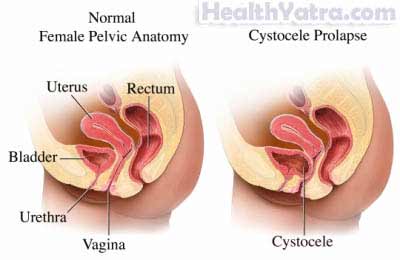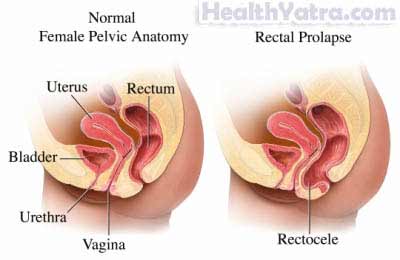Definition
Cystocele and Rectocele Treatment in India: Connective tissue separates the pelvic organs. The tissue, called fascia, is attached to nearby muscles. The fascia and muscles support the bladder, vagina, and rectum. Defects in the fascia can cause cystoceles and rectoceles.
In a cystocele, there is a defect in the fascia between the bladder and vagina. This allows a part of the bladder wall to bulge into the vagina. There are three grades of cystocele:
- Grade 1: mildest form, where the bladder drops only partway into the vagina
- Grade 2: moderate form, where the bladder has sunken far enough to reach the opening of the vagina
- Grade 3: most severe form, where the bladder sags through the opening of the vagina

In a rectocele, there is a defect in the fascia between the rectum and the vagina. This allows part of the wall of the rectum to bulge into the vagina.

The sooner that a cystocele or rectocele is treated, the better the outcome. If you suspect you have this condition, contact your doctor.
Causes
The walls between the vagina and bladder or rectum can be damaged by one or more of the following factors:
- Difficult vaginal births:
- Multiple births
- The use of forceps to assist delivery
- Perineal tears during delivery
- Episiotomy during birth
- Strain from lifting heavy objects
- Chronic cough
- Chronic constipation
- Weakening of vaginal muscles caused by a lack of estrogen after menopause
Risk Factors
Factors that increase your risk for a cystocele or rectocele include:
- Age: postmenopausal
- History of difficult vaginal births
- History of straining during bowel movements
- Obesity
- Smoking
Symptoms
Many cases are mild and do not have symptoms.
In more serious cases, the symptoms of cystocele include:
- Urine leakage while laughing, sneezing, or coughing
- Incomplete bladder emptying after urination
- Pain or pressure in the pelvis
- Pain during sexual intercourse
- Feeling of tissue bulging out of vagina
Symptoms of rectocele include:
- Pain or pressure in the vagina
- Pain during sexual intercourse
- Pain or pressure in the rectum
- Difficult passage of stool
- Needing to apply pressure on vagina to pass stool
- Feelings of incomplete stool passage
- Feeling of tissue bulging out of vagina
If you have any of these symptoms, do not assume it is due to cystocele or rectocele. These symptoms may be caused by other, less or more serious health conditions.
Diagnosis
Your doctor will ask about your symptoms and medical history. A physical exam will be done. You may also have a vaginal and rectal exam. Tests for cystocele may include the following:
- You may need to have images taken of your urine and bowel activity. This can be done with:
- Voiding cystourethrogram
- Defecogram
- Your bodily fluid may need to be tested. This can be done with urine tests.
Treatment
Talk with your doctor about the best plan for you. For the mildest cases of cystocele and rectocele, no treatment is needed. For more serious cases, treatment options include the following:
Activity Modification
- Your doctor may suggest that you avoid heavy lifting.
- Kegel exercises, which involve squeezing the pelvic floor muscles, may help to strengthen the muscles around the vagina and bladder.
- A diet that allows for easy passage of stools may help with a rectocele. The diet should include fiber, liquids, and a stool softener if necessary.
Pessary
A pessary is a device that is inserted into the vagina. It can provide support to keep the bladder and/or rectum in place.
Estrogen Replacement Therapy
Adding estrogen may help strengthen the walls of the vagina after menopause. It may be delivered in the form of pills, creams, or patches.
Surgery
For severe cases, surgery may be needed to move the bladder or rectum back into place.
Prevention
To help reduce your chances of getting cystocele and rectocele, take the following steps:
- Avoid heavy lifting.
- Perform Kegel exercises regularly.
- Treat constipation.
- Quit smoking.
- Maintain a healthy weight.
